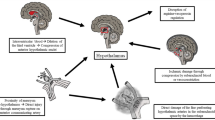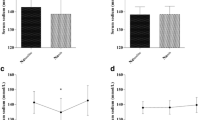Abstract
Purpose
Serum atrial natriuretic peptide (ANP) that is elevated after aneurysmal subarachnoid hemorrhage (SAH) causes diuresis and natriuresis (cerebral salt wasting) and might exacerbate delayed ischemic neurological deficit (DIND). We investigated relationships among hyponatremia, serum ANP elevation, and the onset of DIND after SAH.
Materials and methods
Thirty-nine consecutive patients (15 women and 24 men) with SAH were assigned to a normonatremia group or a group that developed hyponatremia after SAH. Serum ANP and brain natriuretic peptide were assessed after SAH. All patients remained normovolemic and normotensive. We attributed DIND to vasospasm only in the absence of other causes and when supported by cerebral angiography.
Results
Hyponatremia developed after SAH in 11 patients (28.2%), among whom serum ANP concentrations at 0 and 3 days thereafter were significantly increased. Furthermore, DIND developed in five (45.5%) and two (7.1%) hyponatremic and normonatremic patients, respectively (P < 0.05). The serum ANP levels on day 0 after SAH were higher in Hunt and Kosnik grades 3–4 than in 1–2 and in Fisher groups 3–4 than in 1–2 (P < 0.05).
Conclusions
Increasing serum ANP concentrations were independently associated with hyponatremia resulting in DIND. Early treatment of hyponatremia might prevent DIND in patients after SAH.

Similar content being viewed by others
References
Atchison JW, Wachendorf J, Haddock D, Mysiw WJ, Gribble M, Corrigan JD (1993) Hyponatremia-associated cognitive impairment in traumatic brain injury. Brain Inj 7:347–352
Berendes E, Walter M, Cullen P, Prien T, Van Aken H, Horsthemke J, Schulte M, von Wild K, Scherer R (1997) Secretion of brain natriuretic peptide in patients with aneurysmal subarachnoid haemorrhage. Lancet 349:245–249
Doczi T, Joo F, Vecsernyes M, Bodosi M (1988) Increased concentration of atrial natriuretic factor in the cerebrospinal fluid of patients with aneurysmal subarachnoid hemorrhage and raised intracranial pressure. Neurosurgery 23:16–19
Fisher CM, Kistler JP, Davis JM (1980) Relation of cerebral vasospasm to subarachnoid hemorrhage visualized by computerized tomographic scanning. Neurosurgery 6:1–9
Frontera JA, Fernandez A, Schmidt JM, Claassen J, Wartenberg KE, Badjatia N, Connolly ES, Mayer SA (2010) Clinical response to hypertensive hypervolemic therapy and outcome after subarachnoid hemorrhage. Neurosurgery 66:35–41
Harrigan MR (1996) Cerebral salt wasting syndrome: a review. Neurosurgery 38:152–160
Hasan D, Lindsay KW, Wijdicks EF, Murray GD, Brouwers PJ, Bakker WH, van Gijn J, Vermeulen M (1989) Effect of fludrocortisone acetate in patients with subarachnoid hemorrhage. Stroke 20:1156–1161
Hasan D, Wijdicks EF, Vermeulen M (1990) Hyponatremia is associated with cerebral ischemia in patients with aneurysmal subarachnoid hemorrhage. Ann Neurol 27:106–108
Hertel F, Walter C, Bettag M, Morsdorf M (2005) Perfusion-weighted magnetic resonance imaging in patients with vasospasm: a useful new tool in the management of patients with subarachnoid hemorrhage. Neurosurgery 56:28–35
Hunt WE, Kosnik EJ (1974) Timing and perioperative care in intracranial aneurysm surgery. Clin Neurosurg 21:79–89
Igarashi T, Moro N, Katayama Y, Mori T, Kojima J, Kawamata T (2007) Prediction of symptomatic cerebral vasospasm in patients with aneurysmal subarachnoid hemorrhage: relationship to cerebral salt wasting syndrome. Neurol Res 29:835–841
Isotani E, Suzuki R, Tomita K, Hokari M, Monma S, Marumo F, Hirakawa K (1994) Alterations in plasma concentrations of natriuretic peptides and antidiuretic hormone after subarachnoid hemorrhage. Stroke 25:2198–2203
Juul R, Edvinsson L, Ekman R, Frederiksen TA, Unsgard G, Gisvold SE (1990) Atrial natriuretic peptide-LI following subarachnoid haemorrhage in man. Acta Neurochir (Wien) 106:18–23
Katayama Y, Haraoka J, Hirabayashi H, Kawamata T, Kawamoto K, Kitahara T, Kojima J, Kuroiwa T, Mori T, Moro N, Nagata I, Ogawa A, Ohno K, Seiki Y, Shiokawa Y, Teramoto A, Tominaga T, Yoshimine T (2007) A randomized controlled trial of hydrocortisone against hyponatremia in patients with aneurysmal subarachnoid hemorrhage. Stroke 38:2373–2375
McGirt MJ, Blessing R, Nimjee SM, Friedman AH, Alexander MJ, Laskowitz DT, Lynch JR (2004) Correlation of serum brain natriuretic peptide with hyponatremia and delayed ischemic neurological deficits after subarachnoid hemorrhage. Neurosurgery 54:1369–1373
Mori T, Katayama Y, Kawamata T, Hirayama T (1999) Improved efficiency of hypervolemic therapy with inhibition of natriuresis by fludrocortisone in patients with aneurysmal subarachnoid hemorrhage. J Neurosurg 91:947–952
Morinaga K, Hayashi S, Matsumoto Y, Omiya N, Mikami J, Sato H, Inoue Y, Okawara S, Ishimaru K (1995) Therapeutic effect of a mineralocorticoid in patients with hyponatremia of central origin. No To Shinkei 47:671–674
Nakagawa I, Kurokawa S, Takayama K, Wada T, Nakase H (2009) Increased urinary sodium excretion in the early phase of aneurysmal subarachnoid hemorrhage as a predictor of cerebral salt wasting syndrome. Brain Nerve 61:1419–1423
Nakamura T, Okuchi K, Matsuyama T, Fukushima H, Seki T, Konobu T, Nishio K (2009) Clinical significance of elevated natriuretic peptide levels and cardiopulmonary parameters after subarachnoid hemorrhage. Neurol Med Chir (Tokyo) 49:185–191
Nelson RJ, Perry S, Burns AC, Roberts J, Pickard JD (1991) The effects of hyponatraemia and subarachnoid haemorrhage on the cerebral vasomotor responses of the rabbit. J Cereb Blood Flow Metab 11:661–666
Okuchi K, Fujioka M, Fujikawa A, Nishimura A, Konobu T, Miyamoto S, Sakaki T (1996) Rapid natriuresis and preventive hypervolaemia for symptomatic vasospasm after subarachnoid haemorrhage. Acta Neurochir (Wien) 138:951–956
Qureshi AI, Suri MF, Sung GY, Straw RN, Yahia AM, Saad M, Guterman LR, Hopkins LN (2002) Prognostic significance of hypernatremia and hyponatremia among patients with aneurysmal subarachnoid hemorrhage. Neurosurgery 50:749–755
Rabinstein AA, Pichelmann MA, Friedman JA, Piepgras DG, Nichols DA, McIver JI, Toussaint LG 3rd, McClelland RL, Fulgham JR, Meyer FB, Atkinson JL, Wijdicks EF (2003) Symptomatic vasospasm and outcomes following aneurysmal subarachnoid hemorrhage: a comparison between surgical repair and endovascular coil occlusion. J Neurosurg 98:319–325
Soehle M, Czosnyka M, Pickard JD, Kirkpatrick PJ (2004) Critical closing pressure in subarachnoid hemorrhage: effect of cerebral vasospasm and limitations of a transcranial Doppler-derived estimation. Stroke 35:1393–1398
Sviri GE, Shik V, Raz B, Soustiel JF (2003) Role of brain natriuretic peptide in cerebral vasospasm. Acta Neurochir (Wien) 145:851–860
Tomida M, Muraki M, Uemura K, Yamasaki K (1998) Plasma concentrations of brain natriuretic peptide in patients with subarachnoid hemorrhage. Stroke 29:1584–1587
Tsubokawa T, Kurita H, Kaneko N, Iino N, Shiokawa Y (2003) Clinical significance of natriuretic peptides in patients with aneurysmal subarachnoid hemorrhage. No To Shinkei 55:953–960
Weidmann P, Hasler L, Gnadinger MP, Lang RE, Uehlinger DE, Shaw S, Rascher W, Reubi FC (1986) Blood levels and renal effects of atrial natriuretic peptide in normal man. J Clin Invest 77:734–742
Weinand ME, O'Boynick PL, Goetz KL (1989) A study of serum antidiuretic hormone and atrial natriuretic peptide levels in a series of patients with intracranial disease and hyponatremia. Neurosurgery 25:781–785
Wijdicks EF, Schievink WI, Burnett JC Jr (1997) Natriuretic peptide system and endothelin in aneurysmal subarachnoid hemorrhage. J Neurosurg 87:275–280
Wijdicks EF, Vermeulen M, Hijdra A, van Gijn J (1985) Hyponatremia and cerebral infarction in patients with ruptured intracranial aneurysms: is fluid restriction harmful? Ann Neurol 17:137–140
Wijdicks EF, Vermeulen M, van Brummelen P, van Gijn J (1988) The effect of fludrocortisone acetate on plasma volume and natriuresis in patients with aneurysmal subarachnoid hemorrhage. Clin Neurol Neurosurg 90:209–214
Wong GK, Poon WS (2008) Risk of high dose hydrocortisone in patients with aneurysmal subarachnoid hemorrhage. Stroke 39:e12
Author information
Authors and Affiliations
Corresponding author
Rights and permissions
About this article
Cite this article
Nakagawa, I., Kurokawa, S. & Nakase, H. Hyponatremia is predictable in patients with aneurysmal subarachnoid hemorrhage—clinical significance of serum atrial natriuretic peptide. Acta Neurochir 152, 2147–2152 (2010). https://doi.org/10.1007/s00701-010-0735-1
Received:
Accepted:
Published:
Issue Date:
DOI: https://doi.org/10.1007/s00701-010-0735-1




